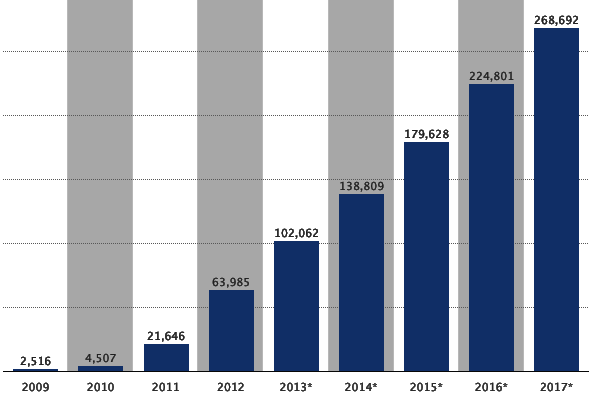2016 was a record-shattering year for the App Store and doesn’t show any sign of slowing down soon. App Annie forecasts that gross mobile app spend – including app store spend and advertising spend – will hit $166 billion in 2017. There’s been continuous growth in the number of companies that are adopting the mobile-first mindset, and realizing that mobile is no longer an optional investment, rather a necessity.
But with so much selection in the app market, users aren’t likely to give an app a second chance once they’ve lost interest. In fact, almost 35% of mobile app engagements last less than a minute, suggesting users don’t take long to find an app that provides them with more value. As a result, it’s become increasingly difficult for companies to develop and release a mobile app that performs well in today’s competitive market.
The Number of Mobile App Downloads Worldwide

Source: Statista
Benchmarking Mobile App Success
The definition of success differs depending on the nature of your app and your business goals. Typically, KPIs for measuring success are reflected in the following:
- Quantity – The number of downloads, percentage of target customers, usage statistics, or other quantitative metrics.
- Revenue Goals – If your app is set to monetize, success may be defined as a revenue figure, which may be driven from paid downloads or via in-app purchases.
The app market is saturated with products that fail to meet user expectations which is why it’s imperative to measure in-app analytics that will reveal patterns of user behavior so you can take actionable steps to optimize the overall user experience.
But before you can even measure success, there’s a harsh reality companies must acknowledge before developing a mobile app, which is that most apps fail. In most cases, there are a number of contributing factors to why this is. Here are 4 mobile app must-haves to help you set your product up for success in the saturated market:
4 Must-Haves for a Successful Mobile App
1. Market & Audience Research
With more than 2.2 million mobile apps available in the App Store today, there’s a great deal of choice for smartphone users so you need to make sure that people actually want or need your app.
Great ideas in theory often don’t make great apps in practice. The decision to launch a product should be research driven. Once you’ve chosen your audience segment, you need to examine your users in greater detail. Do you understand why your target audience will want your product or service? Users are often searching for a solution that will solve a pain they’re experiencing in their life, whether that’s a flawed mobile checkout or an inconvenient personal banking experience.
Pain points motivate users to find a solution that will solve this pain. Identifying your customers’ pain points is the most important step during Product Discovery, otherwise, you’ll end up wasting a lot of time and money building a product that no one wants or needs.
You can validate your product in a number of ways such as user acceptance testing, focus groups, or soft launching. These strategies will help you redefine your idea and understand your users in greater detail. Putting your app through one or some of these validation tests will illustrate precisely how your product will perform in the market.
2. Strategic Marketing & User Acquisition Plan
Many companies often underestimate the time, effort, and resources needed for app awareness and acquisition both before and after launching a mobile app.
Your user acquisition strategy is going to differ based on the nature of your application, your target market, and many other factors. Some of the areas you need to consider when creating a marketing and user acquisition strategy include:
- Early outreach (press and outreach lists, partnerships, etc.)
- Teasers and early access offers (closed beta lists, early sign-up pages)
- Press kits and collateral
- Product sites (Product Hunt, Beta List, CrunchBase, etc.)
- App store optimization and discovery
User acquisition requires ongoing marketing efforts, much like attracting customers for any other business does.
3. Seamless User Experience
There are a lot of components involved in building an app that offers a great user experience, but at the basest level your app needs to be intuitive. If a user struggles to perform basic functions on your app and can’t figure out core functionalities easily, the result is very poor usability. Some other examples of poor user experience include:
- App performance issues (slow or lagging)
- Long load times
- Long registration processes
- Features that are difficult to access
Android and iOS (as well as other platforms) have very intuitive interface guidelines. They operate in different ways, using different gestures and buttons or prompts placed in different areas. For example, Android users are accustomed to a back button that is built into the hardware. Apple devices don’t have this. Failing to account for platform-specific nuances such as these can severely affect the overall user experience (UX).
When developing for multiple platforms, it’s important to build with platform differences in mind. Mobile apps that don’t do this correctly will result in frustrated end users, and given that the average user will decide in less than a minute whether or not your app is worth using, frustration can amount to high abandonment rates.

One thing to pay particular attention to is platform-specific UI/UX best practices. Ignoring these is a costly mistake as each platform has elements that are unique and that their users are accustomed to. For example, minimum sizing for tappable controls or specific swipe gestures will differ from platform to platform, with users expecting results from the actions to be familiar and consistent with other platform applications.
4. Proper Testing
Testing seems like an obvious and critical step in app development, however, it’s estimated that 44% of defects are found by the user, 24% from direct feedback, and another 20% from public user reviews in app stores.

It’s unlikely you’ll get a second chance if you fail to entice users the first time around. Given the competitiveness of the mobile app market, releasing a good product is essential if you hope to be successful.
While it’s rare that an app will be without minor bugs upon launch, making sure you test properly before shipping can ensure there are no major issues. A diligent quality assurance process will help your team deliver a better product to market. If your app lacks proper functionality, your users will abandon the app without hesitation.
Every time your app crashes, lags, or has slow load times, all your other mobile app metrics will be affected as a result. For this reason, it’s important to first track both front-end and back-end functionality to get a thorough understanding of how well your app is performing.
Conclusion
The performance of your app is contingent on a number of different factors that can range from competition to marketing budgets. But beyond these factors, poor research and execution are main causes of app failure. Focusing efforts on market and audience research, following platform-specific best practices, and practicing thorough quality assurance testing can make the difference between failure and success.


